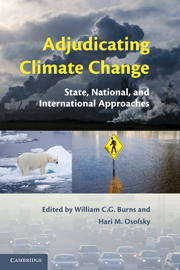Book contents
- Frontmatter
- Contents
- Foreword
- Acknowledgments
- Adjudicating Climate Change
- 1 Overview: The Exigencies That Drive Potential Causes of Action for Climate Change
- PART I SUBNATIONAL CASE STUDIES
- PART II NATIONAL CASE STUDIES
- 6 The Intersection of Scale, Science, and Law in Massachusetts v. EPA
- 7 Biodiversity, Global Warming, and the United States Endangered Species Act: The Role of Domestic Wildlife Law in Addressing Greenhouse Gas Emissions
- 8 An Emerging Human Right to Security from Climate Change: The Case Against Gas Flaring in Nigeria
- 9 Tort-Based Climate Litigation
- 10 Insurance and Climate Change Litigation
- PART III SUPRANATIONAL CASE STUDIES
- 17 Conclusion: Adjudicating Climate Change across Scales
- Index
- References
10 - Insurance and Climate Change Litigation
Published online by Cambridge University Press: 25 August 2009
- Frontmatter
- Contents
- Foreword
- Acknowledgments
- Adjudicating Climate Change
- 1 Overview: The Exigencies That Drive Potential Causes of Action for Climate Change
- PART I SUBNATIONAL CASE STUDIES
- PART II NATIONAL CASE STUDIES
- 6 The Intersection of Scale, Science, and Law in Massachusetts v. EPA
- 7 Biodiversity, Global Warming, and the United States Endangered Species Act: The Role of Domestic Wildlife Law in Addressing Greenhouse Gas Emissions
- 8 An Emerging Human Right to Security from Climate Change: The Case Against Gas Flaring in Nigeria
- 9 Tort-Based Climate Litigation
- 10 Insurance and Climate Change Litigation
- PART III SUPRANATIONAL CASE STUDIES
- 17 Conclusion: Adjudicating Climate Change across Scales
- Index
- References
Summary
INTRODUCTION
To date, most discussion of insurance in relation to climate change has concentrated on the problem of insuring against damage wrought by natural disasters such as Hurricane Katrina, and the particularly destructive 2004 hurricane season. Significant media attention has addressed the posited impact of climate change upon the severity of what insurers term “environmental risks” – property losses occasioned by hurricane, flood, storms, or Earth movement. Most reports focus on property insurance held by persons or entities suffering loss. These losses involve so-called “first-party” insurance in which the policyholder (the first party) makes a claim for repayment of its loss by the insurer (the second party), who in return for a fee (the premium) agreed to indemnify the policyholder should it incur a covered loss. As Hurricane Katrina made all too clear, many Americans are underinsured, particularly with respect to flood insurance.
The public policy debate over effective national risk management policy for property promises to be interesting, even though the realities of political gridlock give little optimism for progress. But however interesting or important, these debates about national insurance and disaster policies tend not to include much analysis of the type of insurance most relevant to climate change litigation, liability insurance, which is potentially at issue when third parties sue policyholders who allegedly inflict injury.
This chapter uses California v. General Motors as a starting point for exploring the liability insurance issues potentially raised by climate change litigation.
- Type
- Chapter
- Information
- Adjudicating Climate ChangeState, National, and International Approaches, pp. 230 - 252Publisher: Cambridge University PressPrint publication year: 2009

